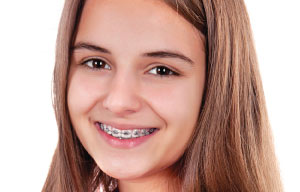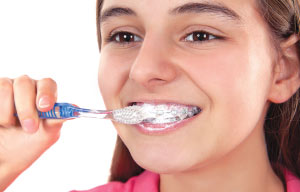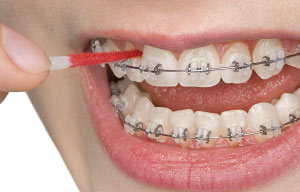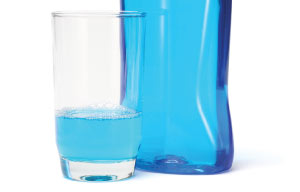Caring For Teeth During Orthodontic Treatment
Optimal Oral Hygiene Is Especially Important While Wearing Braces
Dear Doctor,
Both my teenage daughter and I are in the midst of orthodontic treatment and she is really struggling to keep her mouth clean while wearing braces; even to my eyes her gums look puffy. I am wearing clear aligners, so my job is easier, but do you have any helpful hints?

Dear Morgan,
Keeping one's mouth healthy can be challenging, especially for teens wearing orthodontic hardware. I am happy to share some helpful tips. While there is not well-documented research describing the best approaches for maintaining oral health during orthodontic treatment, there is certainly a lot of knowledge about how to keep the mouth healthy in general, that we can apply to this situation. There are also oral hygiene devices and practices that have proven particularly helpful in removing biofilm — the bacterial layer that collects daily on tooth surfaces and orthodontic appliances — that is the major cause of dental disease.
A Word About Teens
In some ways, teens are at greater risk for dental disease while in orthodontic treatment than adults. Some of a teenager's teeth are newly erupted and therefore have less resistance to tooth decay. Changing hormone levels during growth impact adolescents' health in many ways. Even periodontal (gum) tissues can become more sensitive to dental biofilm, as you are already noticing with your daughter.
The amount of food and biofilm that accumulates on teeth and orthodontic hardware can be staggering, and difficult to remove.
Consuming a healthy, nutritious diet that is low in sugars and processed carbohydrates is important in maintaining oral health. It is equally important to avoid unhealthy snacks between meals, including sodas, and sports and energy drinks. They are high in sugar and very acidic, which can lead to tooth enamel erosion and decay. The amount of food and biofilm that accumulates on teeth and orthodontic hardware can be staggering, and difficult to remove.
What you eat can also affect the kind of bacteria in the biofilm that collects on orthodontic appliances, whether fixed-in braces or removable clear aligners. Because of biofilm's relationship to tooth decay and gum disease, controlling it is at least as important, if not more so, during orthodontic treatment. Someone wearing braces typically has two to three times as much biofilm as someone without braces.
Steps For Staying Healthy
It should almost go without saying that everyone is different, as is their risk for developing dental disease. It is therefore important to have regular visits to your dentist/dental hygienist throughout orthodontic treatment to assess your dental health and risk for disease, and to provide appropriate customized guidance and treatment. Your daily oral hygiene routine should include these steps:

Brushing by itself will probably not control biofilm completely, but it is an important component of any oral hygiene routine. While there is no definitive evidence to suggest that power brushing is better than manual brushing, many dentists and dental hygienists do recommend it, particularly during orthodontic treatment. So you might try both and see what works better for you.
Brushing when wearing braces requires cleaning both above and below the wire that runs through the brackets. A soft multitufted microfine bristle brush that will reach easily in all areas is recommended. Your daughter should start by pointing the brush into the gum line at about a 45-degree angle and brushing the surface between the gum and the wire; she should then go around again and clean from the wire to the edge of the teeth. This needs to be done both on the cheek side and tongue side of all the teeth. She then needs to brush all the chewing surfaces. It is important for your dentist/hygienist to demonstrate the best techniques.
A “clear” advantage of clear aligner trays is that they can be taken out to facilitate oral hygiene. But they, too, create repositories for the accumulation of biofilm, and also prevent saliva, which has antibacterial and other beneficial effects, from coming into contact with the surfaces of oral membranes, teeth and gum tissues.

Cleaning Between Teeth can be accomplished with special floss holders and threaders, as well as very small “interdental” brushes. There is evidence that orthodontic patients who floss have healthier, less inflamed gums then those who don't, although flossing with braces is time consuming. An oral “irrigation” device, which sprays water under pressure, is another helpful option for cleaning between the teeth.
Fluoride products have proven effective in preventing decay and “decalcification,” the early loss of tooth enamel that can precede cavity formation in the decay process. Toothpastes containing fluoride are important in reducing these conditions. Since orthodontic patients have higher counts of decay-producing bacteria, using a toothpaste that contains fluoride is essential. Professionally applied fluoride gels or varnishes are sometimes recommended to prevent and treat decalcification. You may be instructed to use an over-the-counter fluoride mouthrinse daily, or a prescription fluoride toothpaste or mouthrinse may be advised. Your dentist/dental hygienist can offer guidance on this.
Fluoride-releasing orthodontic brackets are currently being researched, and may be useful in the future.

Mouthrinses are available to help reduce biofilm and gingivitis (gum inflammation). There are many over-the-counter and prescription products available. Considered the gold standard in oral rinses, Chlorhexidine, a widely researched antibacterial (prescription only) rinse, is active in reducing gingivitis — though side effects include staining, which is removable, and sometimes temporary alteration of taste. Again, let your dental professional advise you on which product(s) would be best in your case.
As you can see, there are many ways for you and your daughter to keep your mouths and teeth healthy during treatment. Your dental professionals can assess your individual risks for developing problems and tailor an oral hygiene program for each of you that will move you toward beautiful, long-lasting and healthy smiles.

